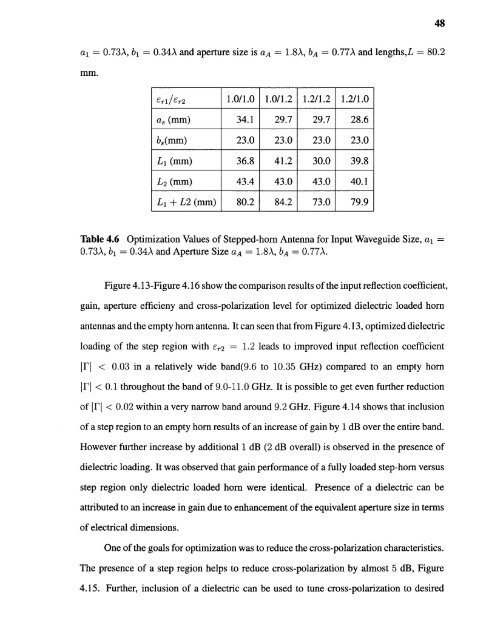Variable permittivity dielectric material loaded stepped-horn antenna
Variable permittivity dielectric material loaded stepped-horn antenna
Variable permittivity dielectric material loaded stepped-horn antenna
You also want an ePaper? Increase the reach of your titles
YUMPU automatically turns print PDFs into web optimized ePapers that Google loves.
48al = 0.73A, b1 = 0.34A and aperture size is aA = 1.8A, bA = 0.77A and lengths,L = 80.2mm.Table 4.6 Optimization Values of Stepped-<strong>horn</strong> Antenna for Input Waveguide Size, al =0.73A, b1 = 0.34A and Aperture Size aA = 1.8A, bA = 0.77A.Figure 4.13-Figure 4.16 show the comparison results of the input reflection coefficient,gain, aperture efficieny and cross-polarization level for optimized <strong>dielectric</strong> <strong>loaded</strong> <strong>horn</strong><strong>antenna</strong>s and the empty <strong>horn</strong> <strong>antenna</strong>. It can seen that from Figure 4.13, optimized <strong>dielectric</strong>loading of the step region with εrg 1.2 leads to improved input reflection coefficientIΓl 0.03 in a relatively < wide band(9.6 to 10.35 GHz) compared to an empty <strong>horn</strong>IF < 0.1 throughout the band of 9.0-11.0 GHz. It is possible to get even further reductionof IΓl < 0.02 within a very narrow band around 9.2 GHz. Figure 4.14 shows that inclusionof a step region to an empty <strong>horn</strong> results of an increase of gain by 1 dB over the entire band.However further increase by additional 1 dB (2 dB overall) is observed in the presence of<strong>dielectric</strong> loading. It was observed that gain performance of a fully <strong>loaded</strong> step-<strong>horn</strong> versusstep region only <strong>dielectric</strong> <strong>loaded</strong> <strong>horn</strong> were identical. Presence of a <strong>dielectric</strong> can beattributed to an increase in gain due to enhancement of the equivalent aperture size in termsof electrical dimensions.One of the goals for optimization was to reduce the cross-polarization characteristics.The presence of a step region helps to reduce cross-polarization by almost 5 dB, Figure4.15. Further, inclusion of a <strong>dielectric</strong> can be used to tune cross-polarization to desired
















